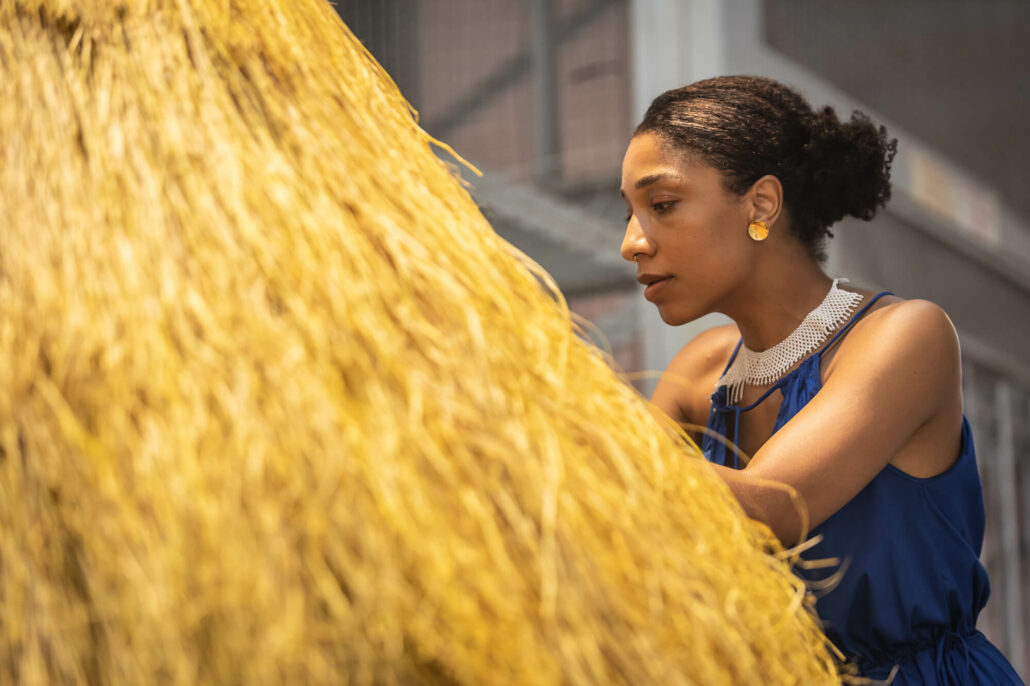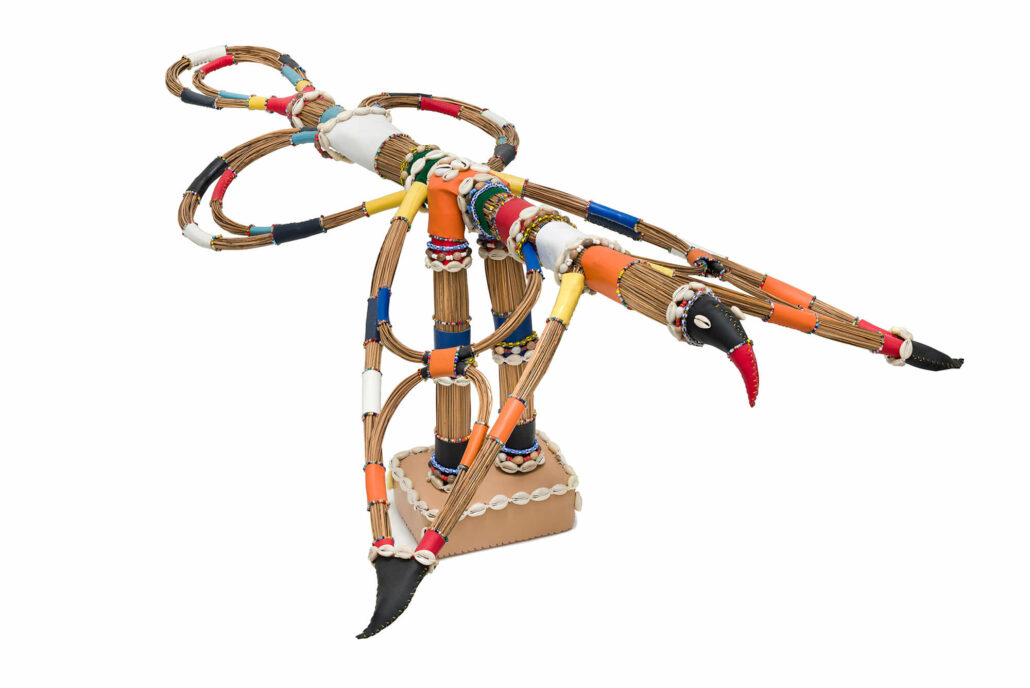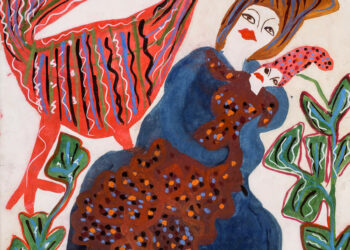As part of the 2023 artistic program, two new exhibitions are opening at Inhotim featuring matters of ancestry and religiosity among Afro-Indigenous people.

Mônica Ventura © Renato Mangolin
Instituto Inhotim is opening two temporary exhibitions on Saturday, May 27, at Galeria Praça. ‘Mestre Didi – “os iniciados no mistério não morrem” (Mestre Didi – “The Initiated Into The Mystery Do Not Die”)’, curated by Igor Simões, along with Inhotim’s curatorial team, and ‘A noite suspensa ou o que posso aprender com o silêncio [The Suspended Night Or What I Can Learn From The Silence]’, by Mônica Ventura; they have a dialogue with matters of ancestry and religiosity among Afro-Indigenous people. The exhibitions are sponsored by Shell, at the Master level, through the Federal Law of Incentive to Culture.
‘A noite suspensa ou o que posso aprender com o silêncio’ was commissioned by Inhotim to occupy the central space of Galeria Praça, one of the most visited galleries in the museum and botanical garden. The work stands out, at first glance, for its scale: it is approximately 4 meters high and 9 meters wide. Mônica Ventura (São Paulo, 1985) presents a proposal to look at the surroundings and the local power, using the soil from the area in the construction of the work – the wall, the base and the sculpture are made from the surrounding earth. ‘A noite suspensa ou o que posso aprender com o silêncio’ is of a scale that is not human and at the same time is not architecture, yet it confronts us. The proposal is to contemplate this installation which looks at us. “Who is observing whom?” asks the artist.
In this work, Mônica Ventura alludes to different religious practices of ancestral matrices. The public is invited to unveil the layers of the installation, whose form is associated with the zangbetos, ancestral spirits worshipped in some religions in the Gulf of Benin, responsible for the protection and warding off evil, and also with the praiás, fundamental elements of Pankararu cosmology, an originary Brazilian people whose traditional territory is near the São Francisco River. For the Pankararu, the praiás mark the presence of the Encantados (the Enchanted), living entities directly linked to the spiritual plane. Both are manifested through dance and using a full-body mask made of straw. In both cases, whoever occupies that body remains unknown; they observe but cannot be observed.
Like an enclosure made of straw, the installation has a blue coloured dome and its earth base affixed to the floor resembles a Yoni, a shape that alludes to the feminine and whose meaning in Sanskrit refers to the notions of “divine passage” or “source of life”. The sculpture itself relates to the Lingam, a phallic symbol that refers to the masculine. The combination of the two forms, seen above, refers to Shiva Lingam, the synthesis of the universe’s energies.
“The central part of Galeria Praça is an extremely challenging space to work with. It is not a white cube, but it is not an outdoor area either. And Mônica sought a composition that articulates and mobilizes both the architectural space and the surrounding garden”, explains Lucas Menezes, Inhotim assistant curator.

Mestre Didi, EYE NLA AGBA – Grande Pássaro Ancestral, 1980. Palm rib, painted leather, whelks and beads, 42 x 72 x 107cm. Courtesy of Divulgação/Instituto Inhotim.
Entering the multiple universes of Deoscoredes Maximiliano dos Santos (1917-2013), Mestre Didi (Master Didi), the exhibition ‘Mestre Didi – The Initiated Into The Mystery Do Not Die’ shows about 30 works by the artist, made following his Candomblé religious leadership activity and belonging to the Instituto Inhotim Collection. According to guest curator Igor Simões, its title is an excerpt from a song sung during the funeral ceremonies of an Ojé, a priest of the Egungun tradition. The exhibited works are made out of dendezeiro palm tree fibres, shells, beads, seeds and leather strips, with symbols that refer to Yoruba traditions.
“As part of its programming, Instituto Inhotim has exhibited its recent acquisitions, focusing on production of Black authorship. The works of Mestre Didi included in the exhibition ratify the mission of the institution to share this production with the general public, always in dialogue with the discussions featuring in the art field”, says Inhotim assistant curator Deri Andrade.
The exhibition invites the public to learn about other dimensions of Mestre Didi, especially Brazilian culture. In addition to his work in the cultural field, Mestre Didi was a supreme priest – also known as Alápini – of the Egungun ancestors’ worship, having founded in the city of Salvador, in 1980, the Sociedade Religiosa e Cultural Ilê Asipá (Ilê Asipá Religious and Cultural Society). All these experiences in Mestre Didi’s trajectory – intellectuality, spirituality and the sacred – are recorded in the exhibition. There are also sculptures from the collection of Sociedade de Estudos da Cultura Negra no Brasil (Society for the Study of Black Culture in Brazil) (SECNEB), and a series of documents and images kindly provided by singer and dancer Inaicyra Falcão, one of Mestre Didi’s daughters. Another aspect addressed in the show is the presence of women in the artist’s trajectory.
“The mysteries of Mestre Didi originate in the pieces and extend to his various existences as Alápini, writer, translator, educator, intellectual and his inseparable presence from the maintenance of the knowledge that united the waters of the Atlantic in the Afrodiasporic experience, which goes beyond the limits of country and expands into a domain that goes beyond the territorial,” says curator Igor Simões.
‘Mestre Didi – The Initiated Into the Mystery Do Not Die’ also features some works that relate to the work of the artist such as Rubem Valentim and Ayrson Heráclito, with the video art Ijó Mimó (2019), as well as commissions from Ilê Asipá, which was in dialogue with the curatorship from the beginning of the research which took place on trips to Salvador.
For Glauco Paiva, executive manager of Communication and Social Responsibility at Shell Brazil, “At Shell, our pillars for cultural sponsorship are diversity and inclusion as central attributes. Supporting Inhotim and, especially, the exhibitions that evoke the protagonism of Afro-Indigenous peoples in our culture strengthen our commitment to build and consolidate these pillars together with Brazilian society.” Notably, the company currently ranks second among the most significant cultural sponsors in the country through incentivized funding.
‘Mestre Didi – “os iniciados no mistério não morrem” [Mestre Didi – “The Initiated Into The Mystery Do Not Die”]’ and ‘A noite suspensa ou o que posso aprender com o silêncio [The Suspended Night Or What I Can Learn From The Silence]’ are part of the Programa Abdias Nascimento e o Museu de Arte Negra [Abdias Nascimento and the Black Art Museum Program]. At the invitation of the curatorship of Instituto Inhotim, Igor Simões will author, besides this exhibition by Mestre Didi, a set of curatorships at the institution still in 2023, integrated into the Abdias Nascimento and the Black Art Museum Program.
For more information, please visit Inhotim.



